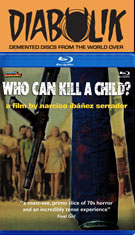
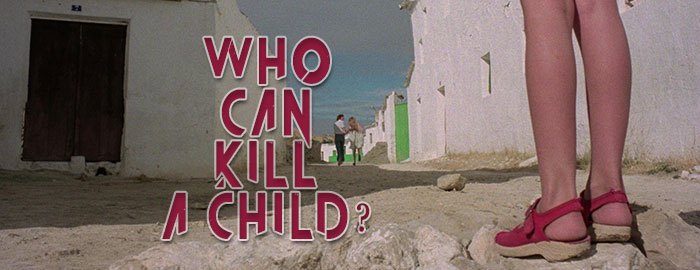
Color, 1976, 111 mins. 12 secs. / 101 mins. 51 secs.
Directed by Narciso Ibáñez Serrador
Starring Lewis Fiander, Prunella Ransome
Mondo Macabro (Blu-ray) (US R0 HD, Dark Sky (DVD) (US R1 NTSC), Divisa (Blu-ray & DVD) (Spain R0 HD/NTSC), Manga (DVD) (Spain R2 PAL), Eureka (DVD) (UK R2 PAL), Cecchi Gori (DVD) (Italy R2 PAL), Nippon (DVD) (Japan R1 NTSC) / WS (1.85:1) (16:9)
If  there were any doubts about the status of
there were any doubts about the status of 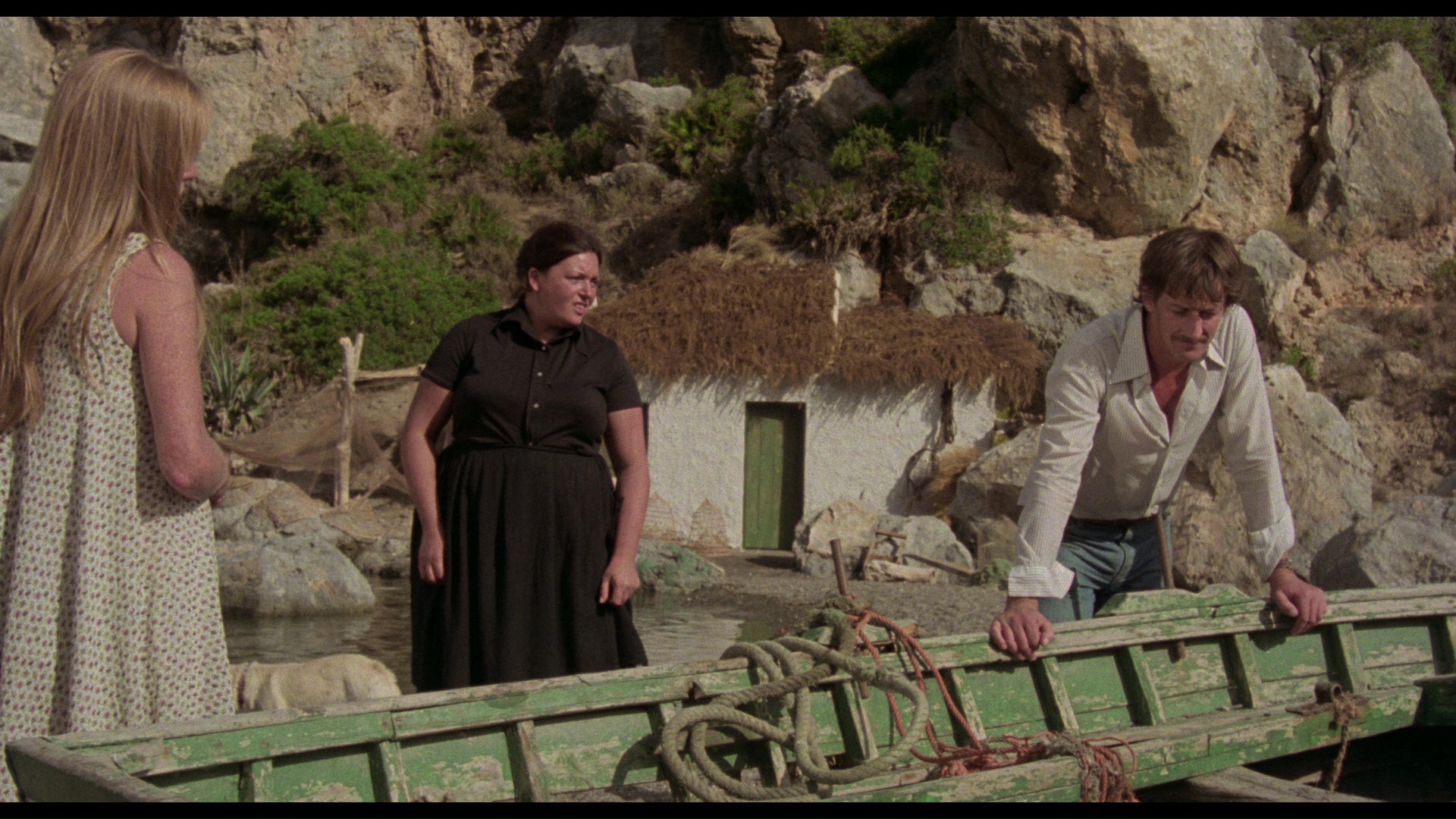 director Narciso Ibáñez Serrador as a pioneering force in Spanish horror after his 1969 masterpiece The House That Screamed, they were easily put to rest with the release of his second (and, to date, last) big screen feature, Who Can Kill a Child? He has since stayed busy in television including multiple incarnations of his terrifying horror anthology series, Historias para no dormir (which would make an incredible English-friendly release someday). With this film he crafted the ultimate example of the horror subgenre of seemingly innocent killer kids on a rampage, something already explored in Devil Times Five and revisited later in films like Bloody Birthday, The Children, Suffer, Little Children, Children of the Corn, and even a 2012 remake of this film, Come Out and Play.
director Narciso Ibáñez Serrador as a pioneering force in Spanish horror after his 1969 masterpiece The House That Screamed, they were easily put to rest with the release of his second (and, to date, last) big screen feature, Who Can Kill a Child? He has since stayed busy in television including multiple incarnations of his terrifying horror anthology series, Historias para no dormir (which would make an incredible English-friendly release someday). With this film he crafted the ultimate example of the horror subgenre of seemingly innocent killer kids on a rampage, something already explored in Devil Times Five and revisited later in films like Bloody Birthday, The Children, Suffer, Little Children, Children of the Corn, and even a 2012 remake of this film, Come Out and Play.
While vacationing along the coast of Spain during the summer's busiest tourist period, Tom (Fiander) and pregnant wife Evelyn (Ransome) find it difficult to find accommodations in town. Tom wants to visit the more remote island Almanzora which he only saw briefly twelve years earlier, and, oblivious to the mysterious slain bodies washing up ashore 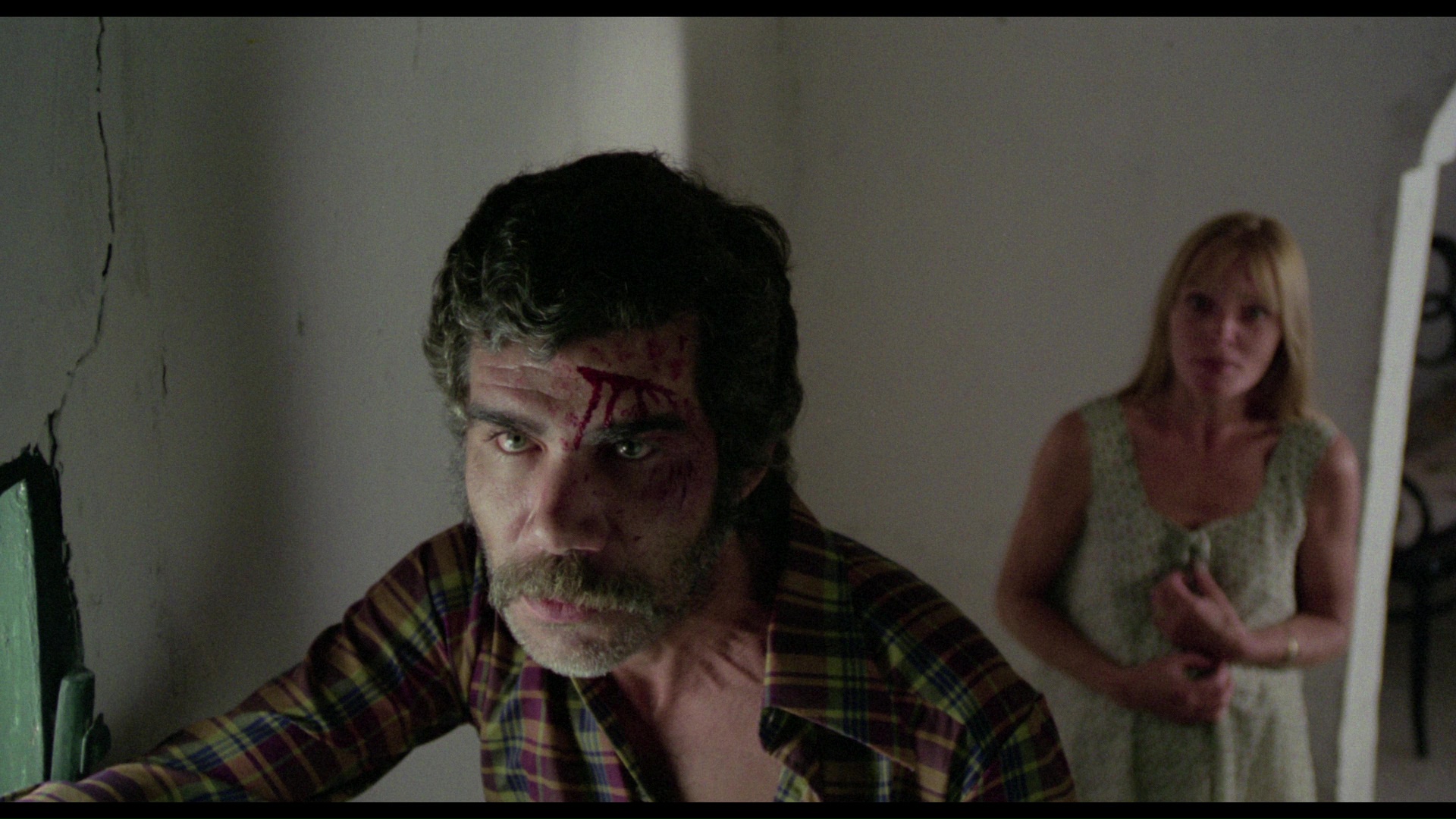 nearby, they make their way to their destination. Unfortunately it seems to be desolate and abandoned at first sight, but soon it becomes evident that there are quite a few
nearby, they make their way to their destination. Unfortunately it seems to be desolate and abandoned at first sight, but soon it becomes evident that there are quite a few  children around... and they aren't in a welcoming mood.
children around... and they aren't in a welcoming mood.
Unnerving in both its narrative simplicity and its deep sense of discomfort, this is a prime example of sunlit horror with its greatest chills coming from the casual suggestion of brutality in even a child's laugh or an exploration of a seemingly deserted building. The really violent scenes are brief but powerful when they hit (the piñata scene is a real shocker), but the suggestion and pacing here are where the film really kicks the viewer in the teeth on the way to an intense climax that's tough to shake off. The ultimate resolution shouldn't be too hard to anticipate if you've seen, well, more than a couple of horror films made in the '70s, but it still works like a charm here.
Due to both its original (almost two-hour) length and subject matter, this film was edited down significantly in numerous countries. The U.S. got one of the shortest versions courtesy of AIP, first under the title Island of the 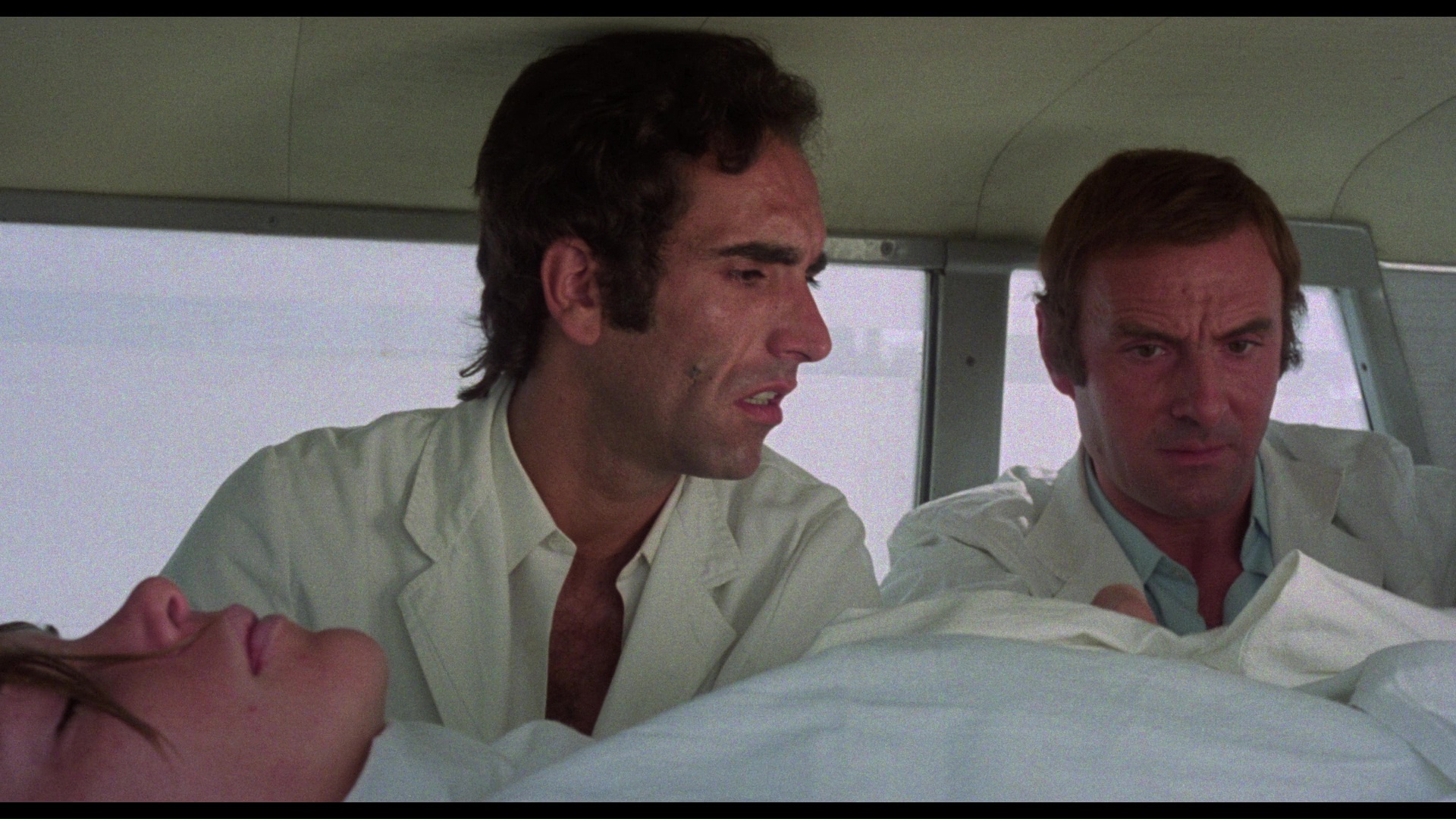 Damned and then on various double bills as The Hex Massacre and Trapped. The original European version opens with a long, extremely grim documentary of sorts during the main titles detailing the atrocities committed
Damned and then on various double bills as The Hex Massacre and Trapped. The original European version opens with a long, extremely grim documentary of sorts during the main titles detailing the atrocities committed 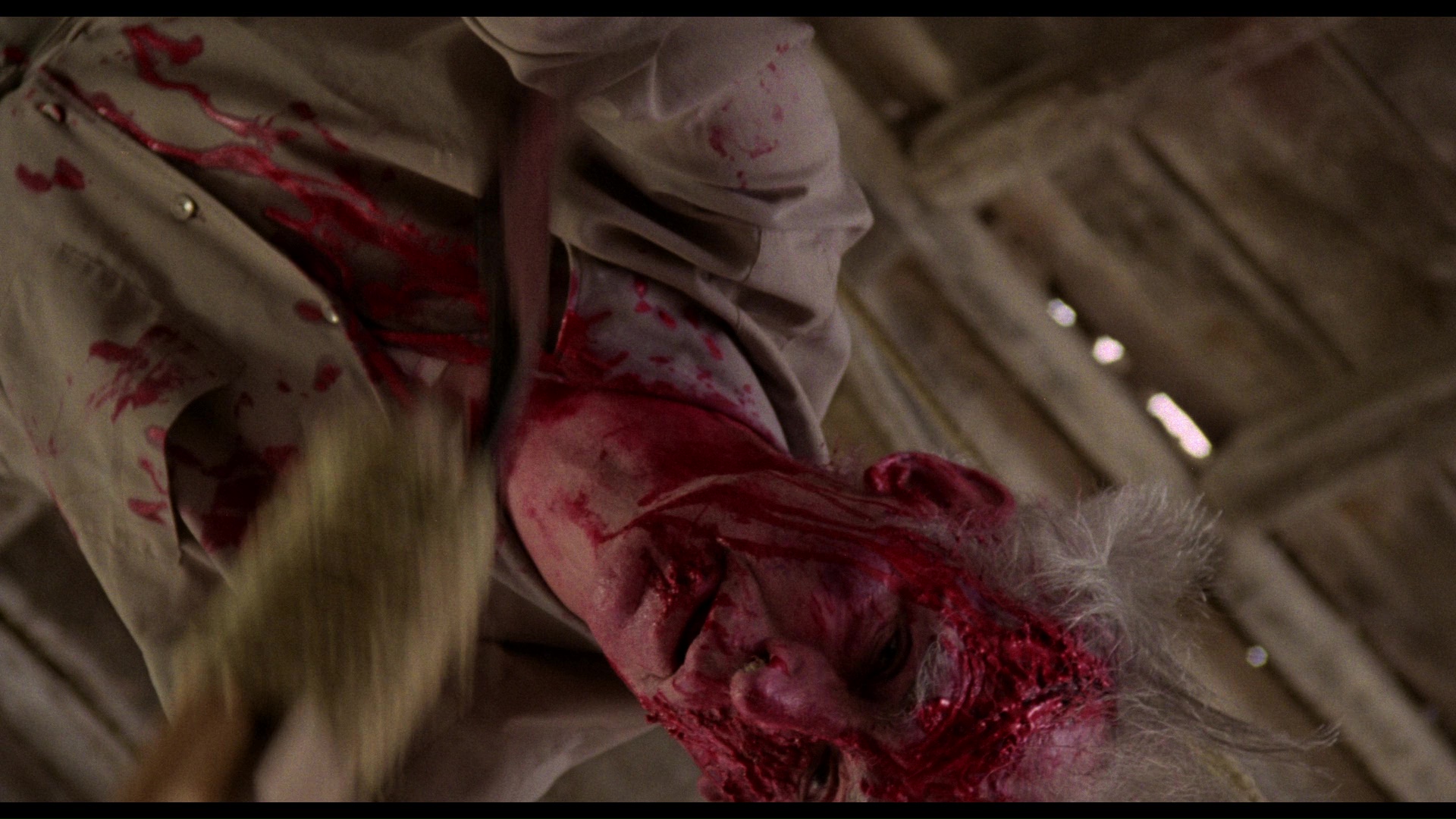 against children in modern times, setting up some context for the narrative to come. It also features quite a bit of additional dialogue scattered around at the beginning detailing some of the local color during the festivities. Interestingly the U.S. version never earned a standalone home video release of any kind, but the uncut version debuted on English-friendly DVD in 2007 from Dark Sky with a fine transfer and two notable extras:a “Who Can Shoot A Child” featurette (16m7s) with cinematographer José Luis Alcaine and a “Child Director” interview (9m13s) with Serrador, plus a still gallery. The Serrador one is fascinating as he explains the disconnect between the film and the "based on" novel listed in the credits, which explained the cause for the children's behavior due to a pollen contagion. The Alcaine one is definitely worthwhile as well, particularly concerning the intended sunny look and the carefully chosen island location. Subsequent DVDs around the world have used the same transfer, while a Spanish Blu-ray (with a mostly English audio option but not English friendly-- more on that below) turned up from Divisa in 2016.
against children in modern times, setting up some context for the narrative to come. It also features quite a bit of additional dialogue scattered around at the beginning detailing some of the local color during the festivities. Interestingly the U.S. version never earned a standalone home video release of any kind, but the uncut version debuted on English-friendly DVD in 2007 from Dark Sky with a fine transfer and two notable extras:a “Who Can Shoot A Child” featurette (16m7s) with cinematographer José Luis Alcaine and a “Child Director” interview (9m13s) with Serrador, plus a still gallery. The Serrador one is fascinating as he explains the disconnect between the film and the "based on" novel listed in the credits, which explained the cause for the children's behavior due to a pollen contagion. The Alcaine one is definitely worthwhile as well, particularly concerning the intended sunny look and the carefully chosen island location. Subsequent DVDs around the world have used the same transfer, while a Spanish Blu-ray (with a mostly English audio option but not English friendly-- more on that below) turned up from Divisa in 2016.
However, the version that easily beats them all is the 2018 edition from Mondo Macabro. Featuring a pin-sharp new 4K transfer from the original negative, the film has never looked better; film grain is fine, textured, 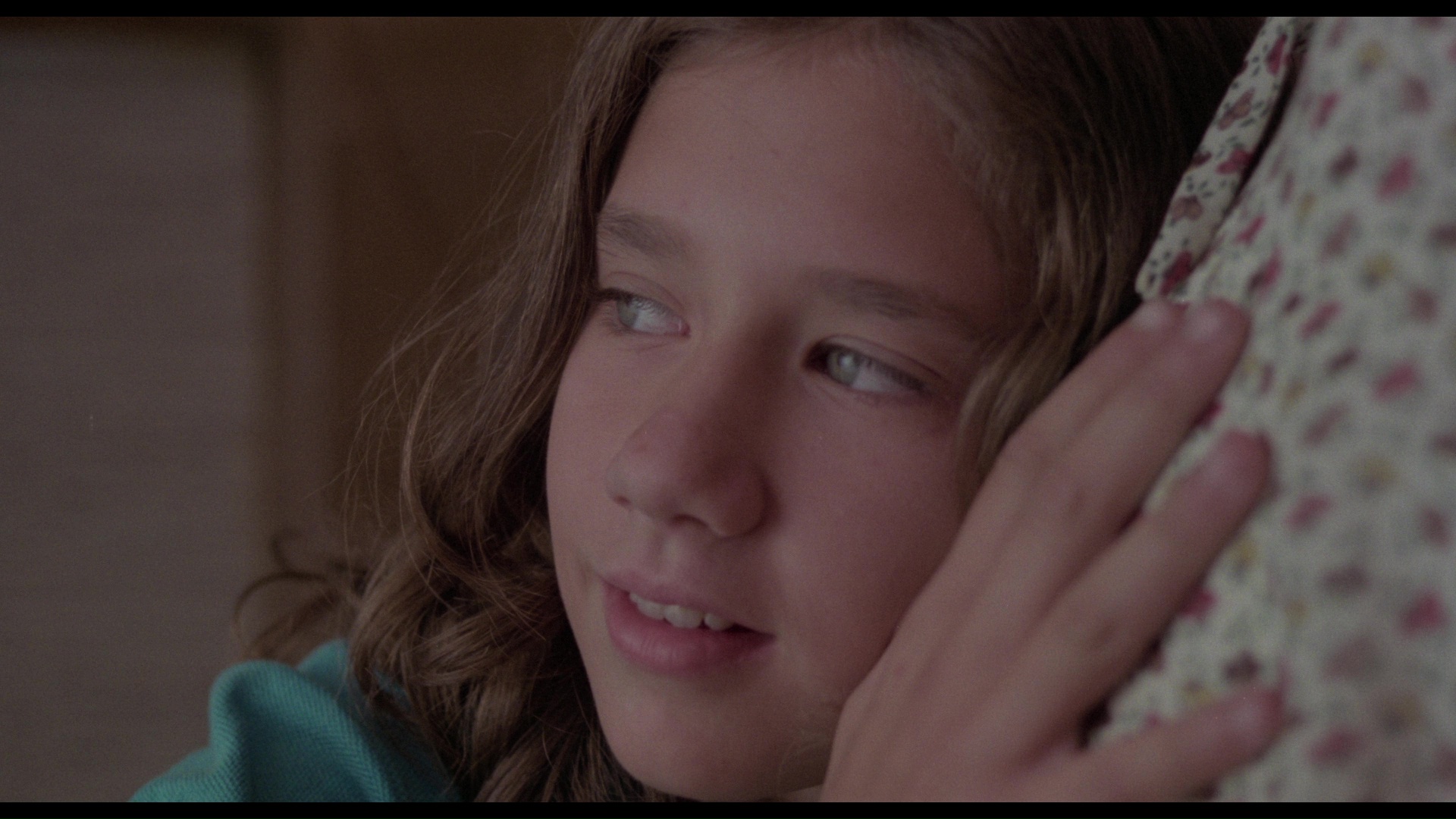 and natural, with the textures of sweat and clothing looking finely detailed throughout. The film can be played with no less than four options (the first familiar from the Dark Sky DVD):
and natural, with the textures of sweat and clothing looking finely detailed throughout. The film can be played with no less than four options (the first familiar from the Dark Sky DVD): 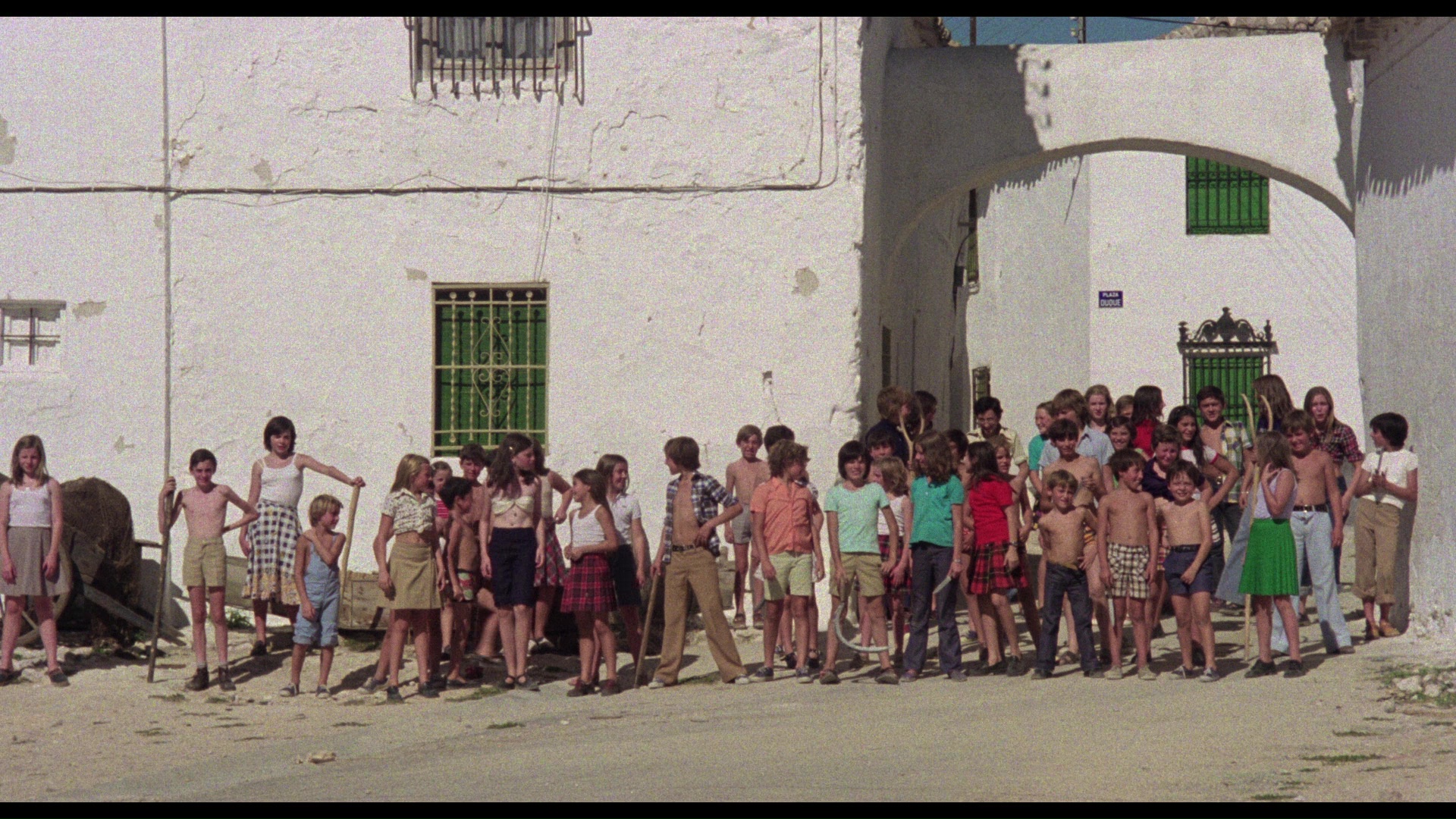 the uncut English version with several interactions with the locals presented in Spanish with English subtitles (this version makes the most sense as it conveys the language barrier behind some key interactions); the same version in Spanish with (newly created) English subtitles; an alternate English version (also with some sequences in subtitles Spanish) derived from the different AIP version; and finally the shorter Island of the Damned, in English and running ten minutes shorter including the entire omission of the European opening. All are DTS-HD MA mono. The film can also be played with a new audio commentary featuring the welcome team of Samm Deighan and Kat Ellinger, who as always are extremely well versed in the horror genre and do a fine job of covering Serrador's career including his familial ties to Spanish showbiz and his importance in the country's television scene. They also touch on everything from Poe to Rosemary's Baby along the way, making salient points throughout.
the uncut English version with several interactions with the locals presented in Spanish with English subtitles (this version makes the most sense as it conveys the language barrier behind some key interactions); the same version in Spanish with (newly created) English subtitles; an alternate English version (also with some sequences in subtitles Spanish) derived from the different AIP version; and finally the shorter Island of the Damned, in English and running ten minutes shorter including the entire omission of the European opening. All are DTS-HD MA mono. The film can also be played with a new audio commentary featuring the welcome team of Samm Deighan and Kat Ellinger, who as always are extremely well versed in the horror genre and do a fine job of covering Serrador's career including his familial ties to Spanish showbiz and his importance in the country's television scene. They also touch on everything from Poe to Rosemary's Baby along the way, making salient points throughout.
Both featurettes from the U.S. DVD have been carried over here, while the previously unreleased "Version Espanola" (46m17s) is a retrospective Spanish TV show featuring Serrador and Alcaine looking back at the 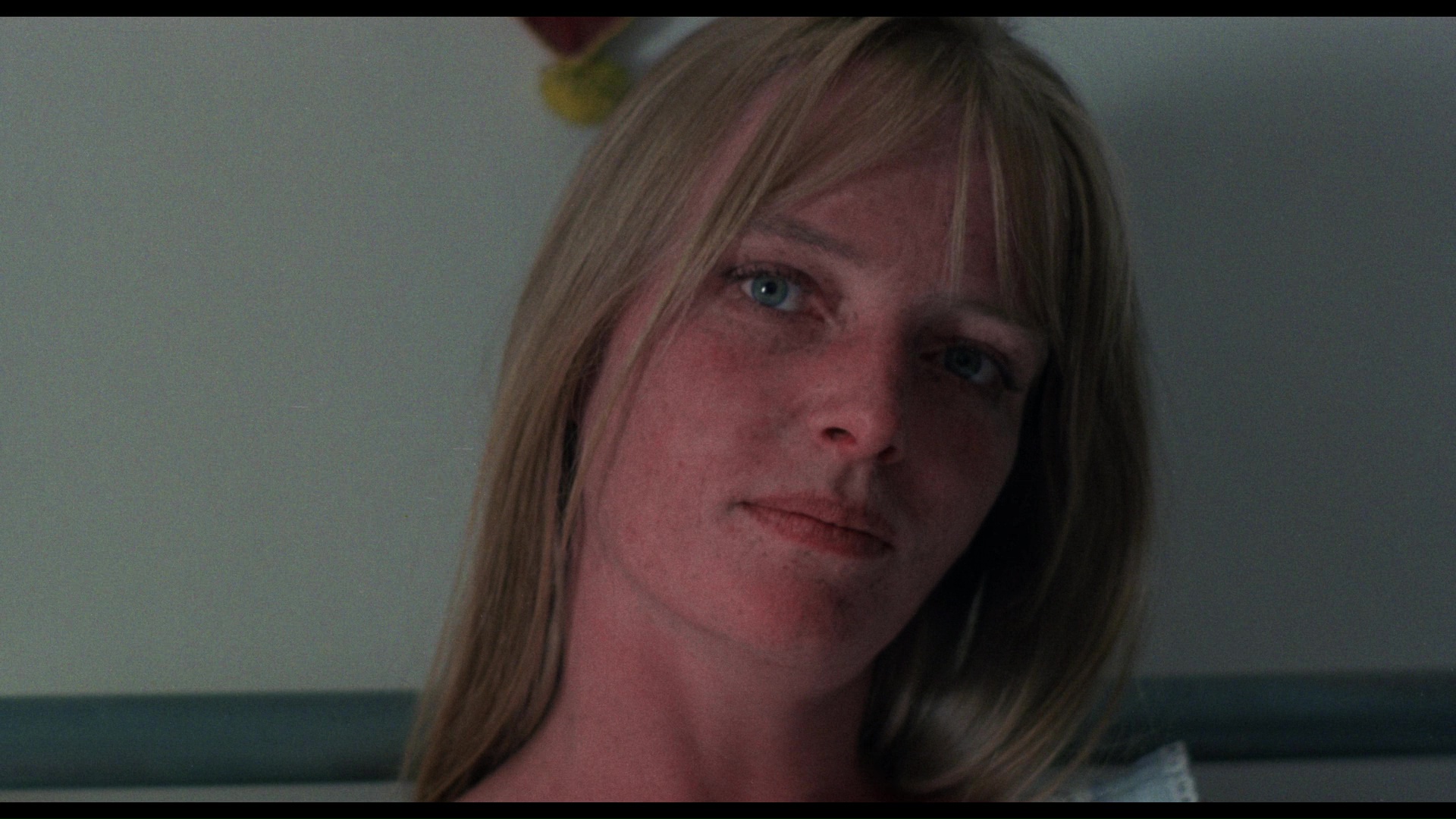 film along with San Sebastian Horror and Fantasy Film Festival Director Jose Luis Rebordinos. It also features some great TV footage of
film along with San Sebastian Horror and Fantasy Film Festival Director Jose Luis Rebordinos. It also features some great TV footage of  Serrador and his dad to give some historical context, and you'll wind up wishing it was a lot easier to see the rest of his work. "Kim Newman on Killer Kids" (14m43s) features the cheerful author and film critic placing this film in the context of movies about homicidal tykes, with predecessors like Village of the Damned forming a thread that goes all the way to the recent narrative flip-flop of Mom and Dad. A trailer for the AIP reissue as The Hex Massacre is included (weirdly scored with snippets from Psycho and The Day the Earth Stood Still) paired up with Lucifer's Curse, a retitling of Holocaust 2000 with Kirk Douglas nowhere in sight. The same double bill is promoted with a batch of radio spots (2m59s) giving it the hardest sell possible, accompanied by a gallery of international poster art and newspaper ads.
Serrador and his dad to give some historical context, and you'll wind up wishing it was a lot easier to see the rest of his work. "Kim Newman on Killer Kids" (14m43s) features the cheerful author and film critic placing this film in the context of movies about homicidal tykes, with predecessors like Village of the Damned forming a thread that goes all the way to the recent narrative flip-flop of Mom and Dad. A trailer for the AIP reissue as The Hex Massacre is included (weirdly scored with snippets from Psycho and The Day the Earth Stood Still) paired up with Lucifer's Curse, a retitling of Holocaust 2000 with Kirk Douglas nowhere in sight. The same double bill is promoted with a batch of radio spots (2m59s) giving it the hardest sell possible, accompanied by a gallery of international poster art and newspaper ads.
Reviewed on June 19, 2018.



 there were any doubts about the status of
there were any doubts about the status of  director Narciso Ibáñez Serrador as a pioneering force in Spanish horror after his 1969 masterpiece The House That Screamed, they were easily put to rest with the release of his second (and, to date, last) big screen feature, Who Can Kill a Child? He has since stayed busy in television including multiple incarnations of his terrifying horror anthology series, Historias para no dormir (which would make an incredible English-friendly release someday). With this film he crafted the ultimate example of the horror subgenre of seemingly innocent killer kids on a rampage, something already explored in Devil Times Five and revisited later in films like Bloody Birthday, The Children, Suffer, Little Children, Children of the Corn, and even a 2012 remake of this film, Come Out and Play.
director Narciso Ibáñez Serrador as a pioneering force in Spanish horror after his 1969 masterpiece The House That Screamed, they were easily put to rest with the release of his second (and, to date, last) big screen feature, Who Can Kill a Child? He has since stayed busy in television including multiple incarnations of his terrifying horror anthology series, Historias para no dormir (which would make an incredible English-friendly release someday). With this film he crafted the ultimate example of the horror subgenre of seemingly innocent killer kids on a rampage, something already explored in Devil Times Five and revisited later in films like Bloody Birthday, The Children, Suffer, Little Children, Children of the Corn, and even a 2012 remake of this film, Come Out and Play.  nearby, they make their way to their destination. Unfortunately it seems to be desolate and abandoned at first sight, but soon it becomes evident that there are quite a few
nearby, they make their way to their destination. Unfortunately it seems to be desolate and abandoned at first sight, but soon it becomes evident that there are quite a few  children around... and they aren't in a welcoming mood.
children around... and they aren't in a welcoming mood.  Damned and then on various double bills as The Hex Massacre and Trapped. The original European version opens with a long, extremely grim documentary of sorts during the main titles detailing the atrocities committed
Damned and then on various double bills as The Hex Massacre and Trapped. The original European version opens with a long, extremely grim documentary of sorts during the main titles detailing the atrocities committed  against children in modern times, setting up some context for the narrative to come. It also features quite a bit of additional dialogue scattered around at the beginning detailing some of the local color during the festivities. Interestingly the U.S. version never earned a standalone home video release of any kind, but the uncut version debuted on English-friendly DVD in 2007 from Dark Sky with a fine transfer and two notable extras:a “Who Can Shoot A Child” featurette (16m7s) with cinematographer José Luis Alcaine and a “Child Director” interview (9m13s) with Serrador, plus a still gallery. The Serrador one is fascinating as he explains the disconnect between the film and the "based on" novel listed in the credits, which explained the cause for the children's behavior due to a pollen contagion. The Alcaine one is definitely worthwhile as well, particularly concerning the intended sunny look and the carefully chosen island location. Subsequent DVDs around the world have used the same transfer, while a Spanish Blu-ray (with a mostly English audio option but not English friendly-- more on that below) turned up from Divisa in 2016.
against children in modern times, setting up some context for the narrative to come. It also features quite a bit of additional dialogue scattered around at the beginning detailing some of the local color during the festivities. Interestingly the U.S. version never earned a standalone home video release of any kind, but the uncut version debuted on English-friendly DVD in 2007 from Dark Sky with a fine transfer and two notable extras:a “Who Can Shoot A Child” featurette (16m7s) with cinematographer José Luis Alcaine and a “Child Director” interview (9m13s) with Serrador, plus a still gallery. The Serrador one is fascinating as he explains the disconnect between the film and the "based on" novel listed in the credits, which explained the cause for the children's behavior due to a pollen contagion. The Alcaine one is definitely worthwhile as well, particularly concerning the intended sunny look and the carefully chosen island location. Subsequent DVDs around the world have used the same transfer, while a Spanish Blu-ray (with a mostly English audio option but not English friendly-- more on that below) turned up from Divisa in 2016.  and natural, with the textures of sweat and clothing looking finely detailed throughout. The film can be played with no less than four options (the first familiar from the Dark Sky DVD):
and natural, with the textures of sweat and clothing looking finely detailed throughout. The film can be played with no less than four options (the first familiar from the Dark Sky DVD):  the uncut English version with several interactions with the locals presented in Spanish with English subtitles (this version makes the most sense as it conveys the language barrier behind some key interactions); the same version in Spanish with (newly created) English subtitles; an alternate English version (also with some sequences in subtitles Spanish) derived from the different AIP version; and finally the shorter Island of the Damned, in English and running ten minutes shorter including the entire omission of the European opening. All are DTS-HD MA mono. The film can also be played with a new audio commentary featuring the welcome team of Samm Deighan and Kat Ellinger, who as always are extremely well versed in the horror genre and do a fine job of covering Serrador's career including his familial ties to Spanish showbiz and his importance in the country's television scene. They also touch on everything from Poe to Rosemary's Baby along the way, making salient points throughout.
the uncut English version with several interactions with the locals presented in Spanish with English subtitles (this version makes the most sense as it conveys the language barrier behind some key interactions); the same version in Spanish with (newly created) English subtitles; an alternate English version (also with some sequences in subtitles Spanish) derived from the different AIP version; and finally the shorter Island of the Damned, in English and running ten minutes shorter including the entire omission of the European opening. All are DTS-HD MA mono. The film can also be played with a new audio commentary featuring the welcome team of Samm Deighan and Kat Ellinger, who as always are extremely well versed in the horror genre and do a fine job of covering Serrador's career including his familial ties to Spanish showbiz and his importance in the country's television scene. They also touch on everything from Poe to Rosemary's Baby along the way, making salient points throughout.  film along with San Sebastian Horror and Fantasy Film Festival Director Jose Luis Rebordinos. It also features some great TV footage of
film along with San Sebastian Horror and Fantasy Film Festival Director Jose Luis Rebordinos. It also features some great TV footage of  Serrador and his dad to give some historical context, and you'll wind up wishing it was a lot easier to see the rest of his work. "Kim Newman on Killer Kids" (14m43s) features the cheerful author and film critic placing this film in the context of movies about homicidal tykes, with predecessors like Village of the Damned forming a thread that goes all the way to the recent narrative flip-flop of Mom and Dad. A trailer for the AIP reissue as The Hex Massacre is included (weirdly scored with snippets from Psycho and The Day the Earth Stood Still) paired up with Lucifer's Curse, a retitling of Holocaust 2000 with Kirk Douglas nowhere in sight. The same double bill is promoted with a batch of radio spots (2m59s) giving it the hardest sell possible, accompanied by a gallery of international poster art and newspaper ads.
Serrador and his dad to give some historical context, and you'll wind up wishing it was a lot easier to see the rest of his work. "Kim Newman on Killer Kids" (14m43s) features the cheerful author and film critic placing this film in the context of movies about homicidal tykes, with predecessors like Village of the Damned forming a thread that goes all the way to the recent narrative flip-flop of Mom and Dad. A trailer for the AIP reissue as The Hex Massacre is included (weirdly scored with snippets from Psycho and The Day the Earth Stood Still) paired up with Lucifer's Curse, a retitling of Holocaust 2000 with Kirk Douglas nowhere in sight. The same double bill is promoted with a batch of radio spots (2m59s) giving it the hardest sell possible, accompanied by a gallery of international poster art and newspaper ads.